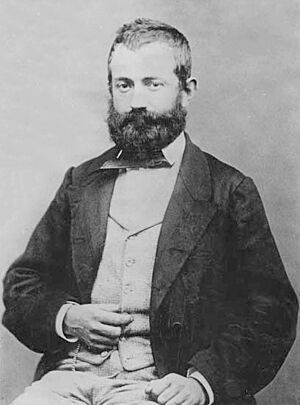Quintino Sella facts for kids
Quick facts for kids
Quintino Sella
|
|
|---|---|
 |
|
| Minister of Finances | |
| In office 14 December 1869 – 10 July 1873 |
|
| Monarch | Victor Emmanuel II |
| Prime Minister | Giovanni Lanza |
| Preceded by | Luigi Guglielmo Cambray-Digny |
| Succeeded by | Marco Minghetti |
| In office 28 September 1864 – 31 December 1865 |
|
| Prime Minister | Alfonso La Marmora |
| Preceded by | Marco Minghetti |
| Succeeded by | Antonio Scialoja |
| In office 3 March 1862 – 8 December 1862 |
|
| Prime Minister | Urbano Rattazzi |
| Preceded by | Pietro Bastogi |
| Succeeded by | Marco Minghetti |
| Personal details | |
| Born | 7 July 1827 Sella di Mosso, Piedmont-Sardinia |
| Died | 14 March 1884 (aged 56) Biella, Italy |
| Political party | Historical Right |
| Alma mater | University of Turin |
| Profession | Economist, mineralogist |
Quintino Sella (born July 7, 1827 – died March 14, 1884) was an important Italian politician, an expert in economics, and a passionate mountaineer. He played a big role in Italy's history, especially in managing the country's money and helping to unite Italy.
Contents
A Life of Learning and Politics
Quintino Sella was born in a place called Sella di Mosso, which is in the Province of Biella, Italy.
He first studied engineering in Turin. In 1843, he went to Paris to learn about mineralogy, which is the study of minerals. While in Paris, he saw the revolution of 1848, a big event where people fought for change.
He came back to Turin in 1852 and started teaching geometry. A year later, in 1853, he became a professor of mathematics at the university. By 1860, he was teaching mineralogy at the engineering school.
Becoming a Leader
In 1860, Quintino Sella was chosen to be a deputy for Cossato. This meant he became a representative in the Italian parliament. Two years later, he became the secretary-general for public education.
In 1862, he was given an important job: the Minister of Finance. This meant he was in charge of the country's money. At that time, Italy had a huge money problem, a "deficit" of 17.5 million lire. A deficit means the government was spending much more money than it was collecting.
Fixing Italy's Money Problems
Sella had to leave his finance job for a short time. But in 1864, he returned to the Ministry of Finance. He worked very hard to fix the country's money issues. He even convinced the king to give up some of his personal allowance. He also asked other government officials to take less pay.
He managed to save a lot of money and proposed new taxes. He even encouraged landowners to pay their land tax early.
He had to resign again, but in 1869, he came back to the finance ministry. He was part of a new government, and he worked with Giovanni Lanza, who became the Prime Minister.
Sella introduced a "grist tax," which was a tax on flour. This was a difficult decision, but it was needed because the country's money situation was very bad. Despite facing strong criticism, he succeeded in making Italy's finances much stronger by 1873.
Important Political Decisions
In 1870, Quintino Sella made a very important decision. He used his influence to stop Italy from helping France in a war against Prussia. He also strongly supported the immediate occupation of Rome. This was a big step in uniting Italy and making Rome its capital.
After 1873, he led a group of politicians called the Right (Destra Storica). He tried to become the head of the government again, but it didn't happen. After 1881, he mostly stepped away from politics to focus on his studies and his linen factory.
A Passion for Mountains
Quintino Sella was a very keen alpinist, which means he loved climbing mountains. Even with his busy political life, he found time to start the Club Alpino Italiano. This club helps people enjoy and explore the mountains safely. Many mountain huts, which are shelters for climbers, are named after him.
He was also involved in the famous competition to be the first to climb the Matterhorn mountain. He even appeared in movies about this event, like The Mountain Calls and The Challenge.
Legacy
Quintino Sella passed away in 1884. He was buried at Oropa. A pyramid-shaped monument was built for him there.
A special mineral was named after him in 1869. It is called sellaite.
Images for kids
See also
- Quintino Sella Hut (Mont Blanc)
- Refuge Quintino Sella au Félik




